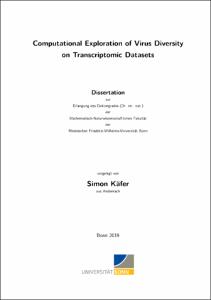Käfer, Simon: Computational Exploration of Virus Diversity on Transcriptomic Datasets. - Bonn, 2019. - Dissertation, Rheinische Friedrich-Wilhelms-Universität Bonn.
Online-Ausgabe in bonndoc: https://nbn-resolving.org/urn:nbn:de:hbz:5n-56561
Online-Ausgabe in bonndoc: https://nbn-resolving.org/urn:nbn:de:hbz:5n-56561
@phdthesis{handle:20.500.11811/8111,
urn: https://nbn-resolving.org/urn:nbn:de:hbz:5n-56561,
author = {{Simon Käfer}},
title = {Computational Exploration of Virus Diversity on Transcriptomic Datasets},
school = {Rheinische Friedrich-Wilhelms-Universität Bonn},
year = 2019,
month = nov,
note = {Most of the ongoing virus research is focused on mammalian and bird viruses, which are well known to be directly or indirectly associated with human diseases. While many viruses are transmitted by blood-feeding arthropods (Arboviruses), virus research on non-bloodfeeding arthropods has long been neglected. Within arthropods, insects are the most diverse animal group on earth and can be found in virtually every habitat. They play a key role in ecosystem health and thus set the basis for many environmental impact assessment studies. The under-estimation of viral diversity was recently made evident by broad sampling of arthropods and other invertebrates. Knowledge about viruses in insects can therefore give insight on the emergence and evolution of viruses. Discovery of yet unknown viruses and consequently, preparedness for emerging diseases are vital to prevent epidemics, especially in the context of globalization. Advancements in metagenomics with rapid growth of available gene databases in recent years have facilitated the exploration of virus diversity.
Transcriptomes from the ’1000 Insect Transcriptome Evolution Project’ (1KITE; http: //1kite.org) have been screened for several groups of RNA viruses. In contrast to a genome, where DNA is sequenced, RNA of a sample is sequenced for a transcriptome. Therefore, only expressed genes of an organism is present in a transcriptome. However, it may contain RNA of viral origin as well. This dataset contains transcriptomes of over 1000 different arthropod species covering all extant orders of hexapods. The primary goal of 1KITE is to solve questions about the evolution of insects but in this study the focus is on the broad range of novel viruses that is expected to be within this large dataset. Since viruses have very high mutation rates and databases have a bias towards viruses that have an impact on humans, livestock, and agriculture, it is required to combine expert knowledge with sensitive search algorithms and appropriate support tools. A new kind of bioinformatic consistency-based virus detection pipeline called TRAVIS (TRAnscriptome VIrus Scanner) is proposed in this study. It is designed for the sensitive mass screening of transcriptomic data directed towards a specific virus group in order to find new, distantly related viruses in addition to closely related. It uses different search algorithms including BLAST, profile Hidden Markov Models (HMMER3) and a new k-mer approach implemented in MMSeqs2. The computational work-flow is mostly automated and delivers statistical and visual output for improved result evaluation.
Specific databases containing different groups of RNA-viruses were used to systematically scan the 1KITE transcriptomes. Hundreds of potential new viruses were identified and partially characterized. While some of those viruses could have been assigned to existing taxonomical groups, the phylogenetic distance of many findings indicate novel virus genera and families.},
url = {https://hdl.handle.net/20.500.11811/8111}
}
urn: https://nbn-resolving.org/urn:nbn:de:hbz:5n-56561,
author = {{Simon Käfer}},
title = {Computational Exploration of Virus Diversity on Transcriptomic Datasets},
school = {Rheinische Friedrich-Wilhelms-Universität Bonn},
year = 2019,
month = nov,
note = {Most of the ongoing virus research is focused on mammalian and bird viruses, which are well known to be directly or indirectly associated with human diseases. While many viruses are transmitted by blood-feeding arthropods (Arboviruses), virus research on non-bloodfeeding arthropods has long been neglected. Within arthropods, insects are the most diverse animal group on earth and can be found in virtually every habitat. They play a key role in ecosystem health and thus set the basis for many environmental impact assessment studies. The under-estimation of viral diversity was recently made evident by broad sampling of arthropods and other invertebrates. Knowledge about viruses in insects can therefore give insight on the emergence and evolution of viruses. Discovery of yet unknown viruses and consequently, preparedness for emerging diseases are vital to prevent epidemics, especially in the context of globalization. Advancements in metagenomics with rapid growth of available gene databases in recent years have facilitated the exploration of virus diversity.
Transcriptomes from the ’1000 Insect Transcriptome Evolution Project’ (1KITE; http: //1kite.org) have been screened for several groups of RNA viruses. In contrast to a genome, where DNA is sequenced, RNA of a sample is sequenced for a transcriptome. Therefore, only expressed genes of an organism is present in a transcriptome. However, it may contain RNA of viral origin as well. This dataset contains transcriptomes of over 1000 different arthropod species covering all extant orders of hexapods. The primary goal of 1KITE is to solve questions about the evolution of insects but in this study the focus is on the broad range of novel viruses that is expected to be within this large dataset. Since viruses have very high mutation rates and databases have a bias towards viruses that have an impact on humans, livestock, and agriculture, it is required to combine expert knowledge with sensitive search algorithms and appropriate support tools. A new kind of bioinformatic consistency-based virus detection pipeline called TRAVIS (TRAnscriptome VIrus Scanner) is proposed in this study. It is designed for the sensitive mass screening of transcriptomic data directed towards a specific virus group in order to find new, distantly related viruses in addition to closely related. It uses different search algorithms including BLAST, profile Hidden Markov Models (HMMER3) and a new k-mer approach implemented in MMSeqs2. The computational work-flow is mostly automated and delivers statistical and visual output for improved result evaluation.
Specific databases containing different groups of RNA-viruses were used to systematically scan the 1KITE transcriptomes. Hundreds of potential new viruses were identified and partially characterized. While some of those viruses could have been assigned to existing taxonomical groups, the phylogenetic distance of many findings indicate novel virus genera and families.},
url = {https://hdl.handle.net/20.500.11811/8111}
}






